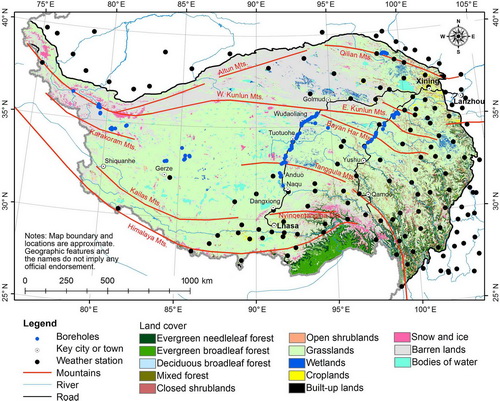Climate Warming Leads to Thermal Degradation of Permafrost in the Qinghai-Tibet Plateau
Updatetime:2018-04-10From:
【Enlarge】【Reduce】
An increase in air temperature often thermally degrade permafrost, which has widespread impacts on engineering design, construction, resource development, carbon and water cycles, and ecological protection in cold regions.
The permafrost in the Qinghai-Tibet Plateau (QTP) experiences higher temperatures than those observed in Siberia and the Arctic, which are more sensitive to global climate warming and human activity.
However, many of studies on permafrost in QTP focus on either the local or in situ scales, and few studies have focused on the regional scale.
Besides, existing studies are not comprehensive and do not adequately reflect changes in the thermal state of the permafrost, especially in the interior of permafrost zones.
Therefore, the thermal state of permafrost should be evaluated with a higher resolution over a longer period than previous studies. However, the evaluated is general limited by the sparse data.
Recently, scientists from Northwest Institute of Eco-Environment and Resources evaluate likely permafrost thermal degradation over the Qinghai-Tibet Plateau (QTP) from the 1960s to the 2000s based on the improved decadal means of the mean annual air temperatures (MAATs) data over the QTP in the past 50 years obtained by integrating remote-sensing-based mean annual land surface temperatures (MASTs), leaf area index (LAI), and fractional snow cover values, as well as decadal mean MAATs measured at 152 weather stations using a geographically weighted regression (GWR) model.
Results showed that the climate warming has led to a thermal degradation of permafrost in the past half century. The total area of thermally degraded permafrost is approximately 153.76×104 km2, which corresponds to 88% of the permafrost area in the 1960s.
In addition, the area occupied by the cold permafrost types has continuously decreased, and the area occupied by the very warm types has continuously increased.
Results also indicated that approximately 49.4% of the very warm permafrost and 96% of the likely thawing permafrost has degraded to seasonally frozen ground.
This degradation may lead to increased risks to infrastructure, reductions in ecosystem resilience, increased flood risks, and positive climate feedback effects. It therefore affects the well-being of millions of people and sustainable development at the Third Pole.
This research has been published on the The Cryosphere in an article entitled “Climate warming over the past half century has led to thermal degradation of permafrost on the Qinghai-Tibet Plateau”.

The distribution of in situ MAAT observation stations and MAGT boreholes over the QTP. (Image by LI Xin)
Contact:
LI Xin
Email: lixin@lzb.ac.cn
Key Laboratory of Remote Sensing of Gansu Province, Heihe Remote Sensing Experimental Research Station, Northwest Institute of Eco-Environment and Resources, Chinese Academy of Sciences, Lanzhou 730000, China.
Appendix




